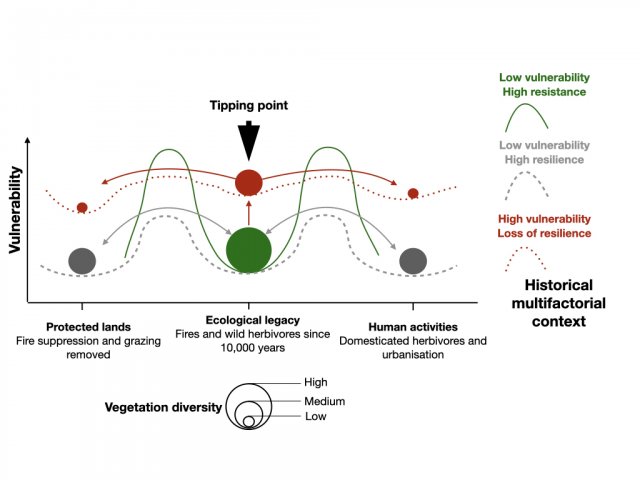Research projects
Fire impacts on biodiversity
The Mediterranean Basin is a world hotspot of biodiversity, in which small islands have become ultimate refugia for the exceptional flora and fauna. I aim to reveal the impact of fire on past vegetation dynamics and its interactions with grazing and human activities on several small islands. I’ll addresses four objectives : 1) quantifying the fire regime (area burnt, frequency, and intensity), 2) quantifying the historical herbivore density, the fuel type and fuel quantity, 3) identifying the long-term vegetation dynamics, i.e. composition, diversity, functional types, and landscape structure, and 4) Identifying ecosystem dynamics of Mediterranean small islands and the implications of the combined drivers effect for conservation.
The resilience of Mediterranean small island ecosystems – the capacity of these systems to return to the state before disturbances – will be evaluated for the Antiquity periods, from where changes in land uses were important and diverse, for the industrialization period, and for the intended management actions of the protected areas.
This unique interdisciplinary methodology will allow to pave the way for a better use of paleoecology lessons into ecosystem management on keystone islands.
Biogeochemical impact of disturbances on ecosystems
Humans have been changing the Earth’s cycles by increasing atmospheric carbon dioxide and fertilizing with nitrogen, a limiting nutrient for forest productivity. With the enrichment of nitrogen, a paradigm of progression from N to phosphorous or calcium limitation has developed. In a short-term period, disturbances, notably fires are regulator of ecosystem processes such as nutrient or carbon cycles, but biogeochemical consequences are particularly difficult to quantify, especially over long time scale. Nonetheless understanding the interactions between climate, disturbances and biogeochemical cycles is crucial regarding the current and future global changes.
The challenge is to understand the impact of disturbance on volatile and nonvolatile nutrients and quantify the intake of these nutrients in lake sediments depending on the type of disturbance and its severity. The first goal is to define the threshold from which soil nutrient losses are significant enough to limit the productivity of the system and change the dynamics or the trajectory of the vegetation. The second goal is to quantify nutrient demands and dynamics of forested as well as non-forested ecosystems, notably temperate grasslands and Mediterranean areas, where fire frequency reconstructions are difficult if not impossible.
Grassland fires in a long-term perspective
Grassland ecosystems represent 40% of the emerged lands but 80% of the fire activity took place in those systems each year. The estimated contribution on carbon release by savannah ecosystems only is currently around 40%, but more investigations are needed to quantify accurately the carbon emissions of all the grassland types. The fire regime in the past could have play a crucial role in the progressive increase of CO2 in the atmosphere, but the high frequency observed today is likely going to exacerbate this trend. A lack of concern over the impacts of environmental change on biodiversity in natural grasslands, and their importance in releasing carbon in the atmosphere persists in part because we currently lack a framework for conceptualizing the role grasslands, and because of the challenges in interpreting charcoal in sedimentary records to decipher the long-term dynamics of grassland systems.
The challenge is to cover the lack of fire histories in grassland systems to maintain this ecosystem containing a high biodiversity of plants and animals, including endangered species. The first goal is then to help fire history reconstruction in grassland ecosystems by calibrating charcoal record with fire parameters, and vegetation assemblages. The second goal is to reconstruct fire history in grasslands, and provided the natural fire regime experienced by these systems in order to manage them accordingly in the future.





